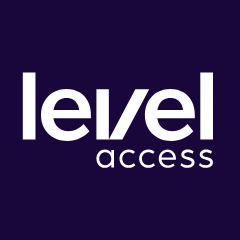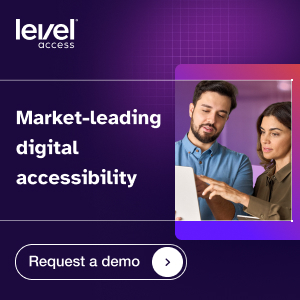The Role of Assistive Technology in Digital Inclusion
Sep 9, 2024
Many people with disabilities use assistive technology every day to access websites and other digital content. Screen readers—such as NVDA and Jaws—are a well-known type of assistive technology, but individuals with disabilities utilize a wealth of other assistive technology tools, often simultaneously or in combination.
In fact, the rise of Artificial Intelligence (AI) is rapidly expanding the range and application of assistive technology for people with disabilities. Below, we will help organizations prepare to integrate assistive technology considerations into their digital inclusion efforts by reviewing examples of assistive technology. We’ll also provide a checklist for ensuring users of assistive technology tools can interact with your digital content.
What is assistive technology?
Assistive technology is an umbrella term for a wide range of tools, including devices, software, and equipment, that enhance learning, working, and daily life for people with disabilities and others with accessibility needs. In fact, the World Health Organization estimates 2.5 billion people worldwide are assistive technology users, with that number projected to reach 3.5 billion by 2050.
Assistive technology takes many forms, from wheelchairs to hearing aids to prostheses. But when it comes to digital accessibility, assistive technology refers to the software and hardware tools that enable people with disabilities to access and interact with web platforms, digital applications, and devices. And in today’s world, most online platforms—desktop and mobile—come with built-in assistive technology.
What are different types of assistive technology?
Several assistive technologies exist to meet the diverse needs of people with disabilities. These tools are crucial for making online content and functionality accessible to users. The most common forms of assistive technology are:
1. Screen readers
Screen reading software converts on-screen text and interactive elements into speech, enabling people with visual disabilities to navigate the web. Screen readers can be independent software (such as NVDA), browser extensions (such as Chrome Vox), or built into operating systems and other software (such as Apple’s iOS Voiceover).
2. Braille displays
A braille display translates digital text and other web elements, such as graphs, into braille, enabling blind or deaf-blind people to interpret web content through touch. Screen readers can also convert on-screen elements into braille format.
3. Screen magnifiers
Screen magnifying tools provide a range of magnification levels for on-screen content and computer pointers, making web interactions easier for people with low or no vision. Some screen magnifiers also provide text-to-speech functions and options to invert colors.
4. Reading assistants
For people with low vision or who have difficulty understanding text content, reading assistants can change the presentation of content and provide other functionality to make it more readable. For example, immersive readers are a type of assistive technology software that can customize fonts, text size, color, spacing, and focus area.
5. Speech recognition software
Speech recognition software allows a user to navigate, type, and interact with a website using their voice. This technology converts spoken words into text, helping people who have difficulty typing navigate the web. In some cases, this software can be used to issue commands to operate a computer. Windows Speech Recognition and Dragon are examples of this software.
6. Keyboard navigation functionality
People with mobility disabilities often have trouble gripping a standard mouse or using a touchpad. Instead, they may navigate through websites with the keyboard only, typically by using the tab key to jump from one item such as a link, header, or list item, to the next. They may also use switches, a type of button device that links to specific keyboard functions to move through and select content.
7. Alternative keyboards
People with mobility or cognitive disabilities may prefer an alternative keyboard, such as a larger keyboard, a one-handed keyboard, a Bluetooth-enabled keyboard, or an on-screen keyboard, to help them interact with web content.
8. Eye tracking devices
Like there are alternative keyboards, there are also alternatives to mouses and pointer devices. Some people with mobility disabilities navigate using devices that track eye movement to determine where a person is focusing and what they want to click on.
How do I make sure assistive technology users can interact with digital content?
Assistive technology only works if a website, app, or platform’s content is appropriately coded for accessibility. Proper coding—like implementing semantic HTML—ensures that people who use assistive technology can effectively comprehend digital content. Below are five areas to consider when accounting for the needs of assistive technology users in your digital accessibility efforts.
Use logical reading order.
Whether you’re creating a website, an app, or a PDF, making sure your content can be navigated in the appropriate order is essential for ensuring assistive technology access. Applying tab-through reading order—that is, properly structuring your content with encoded tags—allows many types of assistive technology, from screen readers to switch devices, to move through menus, text, form fields, buttons, and links.
Apply appropriate ARIA labels.
For sighted users, content is often organized through titles, headings, lists, and tables. And to ensure accessibility, content needs to be accompanied by code that provides similar information about a page’s structure to assistive technologies. Accessible Rich Internet Applications, or ARIA, is one way to accomplish this goal. ARIA supports users of assistive technology by indicating the main structural areas of a page, identifying the roles of user interface elements (such as links and buttons), and clarifying the structure of pages.
Incorporate descriptive link text.
It’s common practice to avoid displaying the full text of a link by connecting it to a word or phrase instead. And that word or phrase matters—especially to users of assistive technology. Screen readers will read out the word or phrase and then identify that it is link text instead of reading the full link address. And if the link text is too general—for example, “here” or “learn more”—users may not know where the link will take them. For this reason, it’s important to use descriptive link text that clearly identifies what is contained in the linked resource.
Ensure all images include alternative text (alt text).
Since all assistive technology software can’t explain an image to a user (although AI assistive technology applications are expanding these possibilities as we speak), it’s important that all images, including icons, graphs, infographics, or other visually displayed information, include accurate alt text. When applying alt text, a best practice is to succinctly describe what information is conveyed by that image, or what purpose it serves (For example, is it an icon?), ideally in 125 characters or less.
Provide equal access to multimedia.
While video and audio content can increase engagement with your website or other digital experience, these media formats can present frustrating barriers for individuals with disabilities. To be accessible, video and audio assets should incorporate assistive technology such as captions, transcripts, and visual descriptions (which describe the visual content of multimedia)—that help those with visual or audiological disabilities have equal access to the content. Making sure your multimedia includes captioning or transcripts not only provides access to individual users of assistive technology—it is often required to provide access for other types of assistive technology, such as screen readers and braille displays.
How do I incorporate assistive technology into my broader digital accessibility efforts?
Assistive technologies are more than just functional tools. These innovations have paved the way for increased independence among people with disabilities, empowering every user to engage with the digital world on their own terms. When digital experiences are created with assistive technology in mind, all people, including those with disabilities, can fully participate in the digital world.
To make sure all types of digital assistive technology can interact with your content, it’s best to engage the support of a third-party expert. Level Access takes a holistic approach to digital accessibility, including providing manual and automated testing, subject matter expertise, training, and ongoing monitoring. Engage with our team today to learn more about how we can help you provide a barrier-free experience for assistive technology users and achieve your overall digital accessibility goals.
FAQ
How is AI expanding digital accessibility?
Artificial Intelligence (AI) is expanding both the application of digital assistive technology and the opportunities for daily use. For example, AI is being leveraged to detect objects in environments and provide guidance for blind and low-vision users, provide personalized assistance and task management for those with cognitive disabilities, and even expand physical accessibility through digital solutions, such as with smart home technology.
What is the difference between digital assistive technology hardware and software?
Assistive technology software refers to website coding, digital tools or applications, and digital services that expand access for people with disabilities. One well-known example of digital accessibility software is AI captioning of audio content. In contrast, digital accessibility hardware refers to any physical devices designed to improve digital accessibility. Examples of digital accessibility hardware include adaptive keyboards, switches, and refreshable braille displays.
What are digital assistive technology best practices?
What digital assistive technology is best for a given situation depends on the individual’s needs and the content being accessed. However, for all digital assistive technology to be effective, content providers need to ensure access so that tools can do their job. You can think of accessibility as a handshake between your digital presence and any tools a person might use. This means digital assistive technology best practices start with making sure your content can work with these tools—whether this happens at the code level or by integrating assistive technology into your presentation of content.
Subscribe for updates



